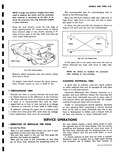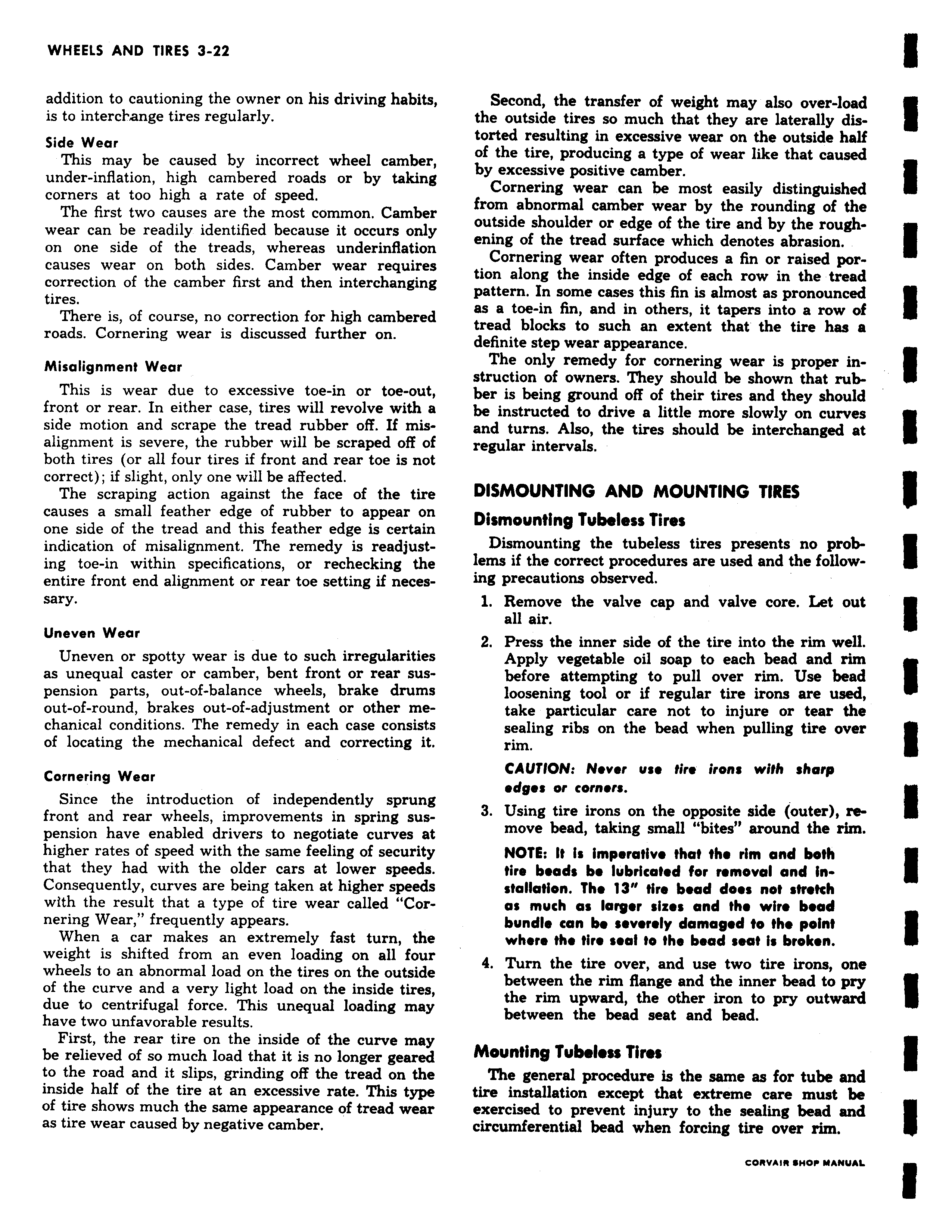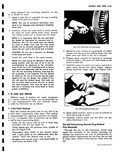Jeep Parts Wiki | Ford Parts Wiki
Home | Search | Browse
Prev

 Next
Next
addition to cautioning the owner on his driving habits is to interchange tires regularly Side Wear This may be caused by incorrect wheel camber under inflation high cambered roads or by taking corners at too high a rate of speed The first two causes are the most common Camber wear can be readily identified because it occurs only on one side of the treads whereas underinflation causes wear on both sides Camber wear requires correction of the camber first and then interchanging tires There is of course no correction for high cambered roads Cornering wear is discussed further on Misalignment Wear This is wear due to excessive toe in or toe out front or rear In either case tires will revolve with a side motion and scrape the tread rubber off If misalignment is severe the rubber will be scraped off of both tires or all four tires if front and rear toe is not correct if slight only one will be affected The scraping action against the face of the tire causes a small feather edge of rubber to appear on one side of the tread and this feather edge is certain indication of misalignment The remedy is readjusting toe in within specifications or rechecking the entire front end alignment or rear toe setting if necessary Uneven Wear Uneven or spotty wear is due to such irregularities as unequal caster or camber bent front or rear suspension parts out of balance wheels brake drums out of round brakes out of adjustment or other mechanical conditions The remedy in each case consists of locating the mechanical defect and correcting it Cornering Wear Since the introduction of independently sprung front and rear wheels improvements in spring suspension have enabled drivers to negotiate curves at higher rates of speed with the same feeling of security that they had with the older cars at lower speeds Consequently curves are being taken at higher speeds with the result that a type of tire wear called Cornering Wear frequently appears When a car makes an extremely fast turn the weight is shifted from an even loading on all four wheels to an abnormal load on the tires on the outside of the curve and a very light load on the inside tires due to centrifugal force This unequal loading may have two unfavorable results First the rear tire on the inside of the curve may be relieved of so much load that it is no longer geared to the road and it slips grinding off the tread on the inside half of the tire at an excessive rate This type of tire shows much the same appearance of tread wear as tire wear caused by negative camber Second the transfer of weight may also over load the outside tires so much that they are laterally distorted resulting in excessive wear on the outside half of the tire producing a type of wear like that caused by excessive positive camber Cornering wear can be most easily distinguished from abnormal camber wear by the rounding of the outside shoulder or edge of the tire and by the roughening of the tread surface which denotes abrasion Cornering wear often produces a fin or raised portion along the inside edge of each row in the tread pattern In some cases this fin is almost as pronounced as a toe in fin and in others it tapers into a row of tread blocks to such an extent that the tire has a definite step wear appearance The only remedy for cornering wear is proper instruction of owners They should be shown that rubber is being ground off of their tires and they should be instructed to drive a little more slowly on curves and turns Also the tires should be interchanged at regular intervals DISMOUNTING AND MOUNTING TIRES Dismounting Tubeless Tires Dismounting the tubeless tires presents no problems if the correct procedures are used and the following precautions observed 1 Remove the valve cap and valve core Let out all air 2 Press the inner side of the tire into the rim well Apply vegetable oil soap to each bead and rim before attempting to pull over rim Use bead loosening tool or if regular tire irons are used take particular care not to injure or tear the sealing ribs on the bead when pulling tire over rim CAUTION Never use lire irons with sharp edges or corner 3 Using tire irons on the opposite side outer remove bead taking small bites around the rim NOTE It is imperative that the rim and both tire beads be lubricated for removal and installation The 13 tire bead does not stretch as much as larger sizes and the wire bead bundle can be severely damaged to the point where the tire soul to the bead seat is broken 4 Turn the tire over and use two tire irons one between the rim flange and the inner bead to pry the rim upward the other iron to pry outward between the bead seat and bead Mounting Tubeless Tire The general procedure is the same as for tube and tire installation except that extreme care must be exercised to prevent injury to the sealing bead and circumferential bead when forcing tire over rim

 Next
Next